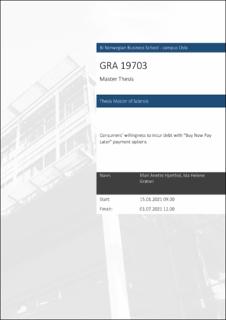| dc.description.abstract | Consumers are offered more payment options than ever before, and many of them
offer exceptionally flexible solutions and different ways of financing purchases
with credit. Simultaneously, the increased credit use has led to a major rise in
consumer debt and debt collection cases in recent years (Dinero, 2019; Kredinor,
2018). The prevalence of interest-free credit options, in addition to the increasing
use of credit for an abundance of goods, has in recent years been implicated as a
cause for the growing amount of personal bankruptcies and household debt,
especially for young adults (Bauer et al., 2021). This study aims to investigate how
Buy Now Pay Later (BNPL) credit payment options influence consumers’
willingness to incur debt. Furthermore, this study wishes to make a societal
contribution by investigating whether certain consumer characteristics representing
vulnerable consumer groups, such as young age, lower levels of self-control and
lower levels of financial literacy, make consumers more inclined to incur debt with
BNPL payment options.
To test this, we conducted an experiment in which participants were presented with
an online purchasing situation, as observed in the study of Bauer et al. (2021). The
participants were randomly assigned to either BNPL or credit card (a more
traditional credit payment option), and followingly asked about their willingness to
incur debt with the payment option. The respondents were then asked a set of
questions related to their levels of self-control and financial literacy, as well as their
demographics. The results of this study were tested using Andrew F. Hayes’
PROCESS software in SPSS. The evidence suggests that the consumer’s
willingness to incur debt is higher for BNPL than with credit card, due to lower
levels of transparency and higher levels of convenience. The evidence also suggests
that vulnerable consumers (i.e., young consumers and consumers that lack financial
literacy) are more willing to incur debt with BNPL than the general consumer. The
implications of this study are related to the lack of regulations placed upon BNPL
providers in Norway today. This study aims to prompt regulators to ensure the
protection of consumers against the potential negative consequences of BNPL.
Whilst BNPL can be a valuable and effective mean of payment, it is indeed a form
of credit debt, and should therefore be regulated as such. | en_US |
